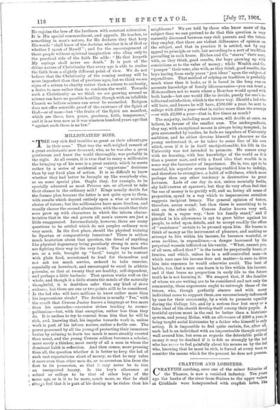CRAYFISH AND LOBSTERS.
CRAYFISH catching, once one of the minor 'fisheries Of the Thames, is now a vanished industry. Ten years ago the banks of the river from Staines to the upper waters at Cricklade were honeycombed with crayfish boles, like Bandmartins' nests in a railway cutting. These holes were generally not more than 18 in. below the normal water line of the river. In winter when the stream was full fresh holes were dug higher up the bank. In summer when the water fell these were deserted. The result was that there were many times more holes than crayfish, and that for hundreds of miles along the Thames and its tributaries these burrows made a perforated border of about 3 ft. deep. The almost complete destruction of the crayfish was due to a disease, which first appeared near Staines, and worked its way up the Thames, with as much method as enteric fever worked its way down the Nile in the Egyptian Campaign after Omdurman. The epidemic is well known in France, where a larger kind of crayfish is reared artificially in ponds, and serves as the material for bisque crecrevisses, and as the most elegant scarlet garnish for cold and hot dishes of fish in Paris restaurants ; but it was absolutely new to recent experience of the Thames. Perhaps that is why its effects were so disastrous. The neat little fresh- water lobsters turned almost as red as if they had been boiled, crawled out of their boles, and died. Under some of the most closely perforated banks they lay like a red fringe along the riverside under the water. Near Oxford, and up the Cherwell, Windrush, and other streams they were so numerous that making crayfish pots was as much a local industry as making eel pots, the smaller withes, not much larger than a thick straw, being used for this purpose. Every cottage near the river had one or two of these pots, which were baited on summer nights and laid in the bottom of the stream near the crayfish holes. It must be supposed that they only use them by day, and come out by night, just as lobsters do, to roam about and seek food on a larger scale than that which they seize as it floats past their holes by day. That time of more or less enforced idleness the crayfish used to spend in looking out of their boles with their claws hang- ing just over the edge ready to seize and haul in anything nice that floated by. Their appetite by night was such that no form of animal food came amiss to them. The "pots" were baited with most unpleasant dainties, but nasty as these were they were not so unsavoury as the food which the crayfish found for themselves and thoroughly enjoyed, each as dead water-rats and dead fish, worms, snails, and larvm. They were always hungry, and one of the simplest ways of catching them was to push into their holes a gloved finger, which the creature always seized with its claw and tried to drag further in. The crayfish, who, like the lobster, looked on it as a point of honour never to let go, was then jerked out into a basket. They rather liked the neighbourhood of towns and villages because plenty of dirty refuse was thrown into the water. In the canalised stream which runs into Oxford City itself there were numbers, which not only burrowed in the bank, but made homes in all the chinks of stone and brick river walls, and sides of locks, and in the wood of the weiring, where they sat ensconced as snugly as crickets round a brick farmhouse kitchen fireplace. These were regularly caught by the families of the riverine population of boatmen, bargees, and waterside labourers, and sold in the Oxford market. A dish of crayfish, as scarlet as coral, was not un- frequently seen at a College luncheon. Possibly the recovery from the epidemic may be rapid, and the small boys of Medley and Mill Street may earn their sixpence a dozen as delight- fully as they used to. The neatest and most sportsmanlike method of capturing the crayfish was by snaring him with a willow wand. A long flexible willow was cut, and about three inches removed from the top without completely severing the bark ; this was then trimmed with a knife, and twisted into a delicate noose about an inch across. The sportsman then betook himself to some old lock or bank where crayfish were numerous, and leaning over looked up or down the stream to mark any pairs of claws hanging out of the holes. Selecting the largest, he would carefully push the noose towards the hole, and then drop it over one or both claws, and so haul the animal—we are forbidden to call it a fish, though Colonel Newcome called a lobster one—out of its burrow. Young crayfish, when hatched from the egg, are almost exactly like their parents. The female nurses and protects them, carrying them attached to its underside in clinging crowds. They grow very fast, and this makes it necessary for the youthful cray- fish to " moult "or shed their shells eight times in their first twelvemonth of life, as the shell is rigid and does not grow
with the body. The constant secretion of the lime necessary to make these shells is so exhausting to the youthful crayfish that only a small number ever grow up. In America, where a large freshwater crayfish nearly a foot long is found, these burrowing habits are a serious nuisance, especially in the dykes of the Mississippi. In those streams from which these interest- ing little creatures have entirely disappeared it might be worth while to introduce the large Continental crayfish. As it is bred artificially, there would be no difficulty in obtaining a supply, and it would be a useful substitute for the small native kind.
An experiment on a large scale has recently been made in the United States in artificially breeding lobsters to replenish the stock now somewhat depleted by the great " canning " industry. The method of obtaining the young lobsters is different from that employed to rear trout from ova. The female lobsters carry all their eggs fastened to hair-fringed fans or " swimmerets" under their tails, the eggs being glued to these hairs by a kind of gum which instantly hardens when it touches the water. For some ten months the female lobster carries the eggs in this way, aerating them all the time with the movement of the swimmerets. When they are caught in the lobster-pots in the months of June and July, the eggs are taken to the hatchery, and the ova are detached. As they are already fertilised, they are put into hatching jars, where in due course they become young lobsters, or rather lobster larvm, for the lobster does not start in life quite so much developed as does the infant crayfish. It is about one-third of an inch long, has no large claws, and swims naturally on the surface of the water, instead of lurking at the bottom as it does when it has come to lobster's estate. It seems to be compelled to rise to the surface, for sunlight, or any bright illumination, always brings swarms of lobsterlings to the top of the jars in which they are hatched. In the sea this impulse towards the light stands them in good stead, for in the surface-waters they find themselves surrounded by the count- less atoms of animal life, of potential life, the eggs and young of smaller sea beasts. It is furiously hungry and voracious, because, like the young crayfish, it has to change not only its shell but the lining of its at,mach five times in eighteen days. Unfortunately, in the hatching jars there is no such store of natural food as in the sea. The result is that the young lobsters have to eat each other, which they do with a cheerful mind, if they are not at once liberated. Hence, the United States lobster hatchery is not responsible to its alumnz for more than their start in life. When the young lobsters have reached their fifth month they go to the bottom and "settle down" in the literal sense to the serious life of lobsters. They find or dig holes, in which they live by day like sea rabbits, and come out by night to feed and roam. According to the report of the Commissioners of Fisheries, Game, and Forests of the State of New York, they grow very slowly, and when eating lobster we are consuming the production of several years of development. From 2 in. to 3 in. is the maximum growth of the first year. In two years this has increased to 5 in. or 7 in. if food is plentiful. At the end of five years the lobster may be 10 in. long. It is also fairly certain that the female lobster only lays eggs once in two years, because it moults in the alternate years, and has no spare energy left for reproduction. In lobster-catching circles there is con- siderable doubt as to the age to which the creatures may possibly live. There seems no particular reason why a lobster should ever die of old age, though it often finds it difficult to escape its enemy, the large cuttle- fish, which crushes and eats it wherever it may be, even in its own hole in the rocks. But there is no doubt that they do die of old age, because they have been found in articulo mortis apparently for no other reason. It is well known that sea animals often come to the shore when ill or dying. Not long ago a very large and very old lobster was found in a shallow pool off the Lincoln- shire coast, evidently dying of general decay. It was covered with sea-shells and parasites, and was blind and very feeble. The Isle of Wight fishermen say that when mature a lobster's age may be guessed from its weight. Each half-pound repre- sents a year. Perhaps the largest Isle of Wight lobster was one of 8lb. caught under the steps of the Needles Lighthouse. This would represent an age of sixteen years. The largest lobster yet recorded as taken in the United States weighed 33 lb.



































 Previous page
Previous page